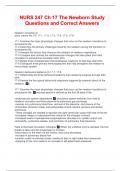Tentamen (uitwerkingen)
NURS 247 Ch 17 The Newborn Study Questions and Correct Answers
- Vak
- Instelling
Newborn transition to extra uterine life (17) 17-1, 17-2, 17-3, 17-4, 17-5, 17-6 17-1 Examine the major physiologic changes that occur as the newborn transitions to extrauterine life. 17-2 Determine the primary challenges faced by the newborn during the transition to extrauterine life. 17-3 Interp...
[Meer zien]




